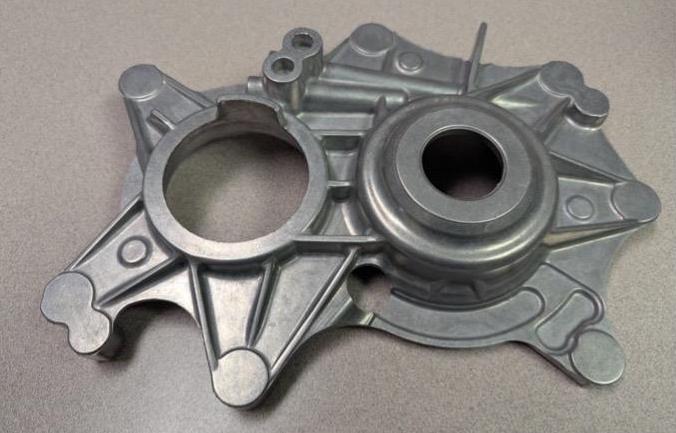
Oak Ridge National Laboratory (ORNL), part of the U.S. Department of Energy (DOE), developed a new recycled-aluminum alloy, called RidgeAlloy. The alloy is produced by remelting post-consumer scrap aluminum and recasting it into a material that meets the strength, ductility and crashworthiness standards for structural vehicle parts. This is expected to enable the transformation of low-value scrap into a high-value domestic supply chain for manufacturing new structural automotive parts.
“The team advanced from a paper concept to a successful, full-scale part demonstration of a new alloy in only 15 months,” said Allen Haynes, director of ORNL’s Light Metals Core Program. “That’s an unheard-of pace of innovation in developing complex structural alloys.”
Recycling Automotive Aluminum Scrap
Ford introduced its aluminum-intensive F-150 truck series in 2015, making it the first mass produced vehicle to be made of aluminum in the U.S. market. Since then, numerous cars and trucks have begun using aluminum in their designs. By the early 2030s, many of these vehicles are projected to reach end-of-life, creating a surge of high-quality aluminum body sheet scrap — up to 350,000 tons annually in North America.
Fortunately, the U.S. has some of the world’s best infrastructure for vehicle shredding and aluminum scrap recovery. However, when vehicles are disassembled and shredded, the aluminum is often mixed with other metals and materials (such as iron). This scrap is often too impure to safely be reused in new critical automotive parts and is instead downcycled into low-grade castings, limiting its value, or exported, which is a missed opportunity to use those resources as a source of high-quality domestic aluminum.
“You can repurpose post-consumer aluminum into something non-structural like engine blocks,” said Alex Plotkowski, ORNL group leader of Computational Coupled Physics. “But it won’t have the properties needed for higher value, structurally sound body applications.”
Developing RidgeAlloy
To address this issue, the ORNL team at Spallation Neutron Source, a DOE Office of Science user facility, applied world-class scientific tools — such as high-throughput computing, which involved more than two million calculations, as well as materials characterization and neutron diffraction — to predict the optimal alloy compositions with targeted properties. These tools helped the researchers understand how specific impurities affect alloy behavior. Neutrons are uniquely suited for this kind of research because they can penetrate deep into dense metals without damaging the material, allowing scientists to observe internal structures and atomic-scale changes.
After pinpointing the desired blend through rapid computational predictions and laboratory trials, the new alloy was tested in a real-world environment. Trialco Aluminum in Chicago, IL, supplied recycled aluminum ingots cast from mixed auto body sheet scrap and tailored to RidgeAlloy’s specifications. Then, the ingots were shipped to Falcon Lakeside Manufacturing in Michigan, where they were successfully cast into automotive parts using high-pressure die-casting.
“The part we chose was medium-sized and moderately complex,” said Plotkowski. “The ultimate goal is to eventually cast larger parts, perhaps even automotive giga-castings, but this is the first step.”
The cast parts confirmed that RidgeAlloy, consisting of aluminum, magnesium, silicon, iron, and manganese, had the combination of properties necessary for structural vehicle castings, even when made from recycled blends with higher iron and silicon content. The alloy delivers strength, corrosion resistance, and ductility, enabling the production of structural castings of underbodies, frame components and other critical parts from post-consumer aluminum scrap.
This breakthrough offers an opportunity to ensure that North American auto body sheet scrap is properly valued, with it being sorted and reused in new auto body sheet. RidgeAlloy could enable recycled structural castings at volumes equal to at least half of the annual primary aluminum production in the U.S. by the early 2030s. This would reduce energy use, cut costs and strengthen domestic supply chains.
“RidgeAlloy offers the first technology capable of recapturing the value of a fast-approaching and historically massive wave of domestic, high-quality recycled automotive aluminum sheet alloys,” said Haynes. “That’s the big picture supply chain impact our team aimed for.”
The project team from ORNL included Alex Plotkowski, Amit Shyam, Allen Haynes, Sunyong Kwon, Ying Yang, Sumit Bahl, Nick Richter, Severine Cambier, Alice Perrin, and Gerry Knapp. This research was supported by DOE’s Office of Energy Efficiency and Renewable Energy, and developed under the Vehicle Technologies Office Lightweight Metals Core Program.
